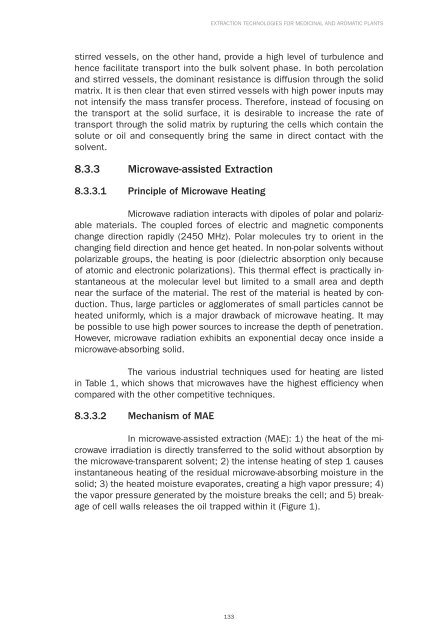Extraction Technologies For Medicinal And Aromatic Plants - Unido
Extraction Technologies For Medicinal And Aromatic Plants - Unido
Extraction Technologies For Medicinal And Aromatic Plants - Unido
You also want an ePaper? Increase the reach of your titles
YUMPU automatically turns print PDFs into web optimized ePapers that Google loves.
EXTRACTION TECHNOLOGIES FOR MEDICINAL AND AROMATIC PLANTS<br />
stirred vessels, on the other hand, provide a high level of turbulence and<br />
hence facilitate transport into the bulk solvent phase. In both percolation<br />
and stirred vessels, the dominant resistance is diffusion through the solid<br />
matrix. It is then clear that even stirred vessels with high power inputs may<br />
not intensify the mass transfer process. Therefore, instead of focusing on<br />
the transport at the solid surface, it is desirable to increase the rate of<br />
transport through the solid matrix by rupturing the cells which contain the<br />
solute or oil and consequently bring the same in direct contact with the<br />
solvent.<br />
8.3.3 Microwave-assisted <strong>Extraction</strong><br />
8.3.3.1 Principle of Microwave Heating<br />
Microwave radiation interacts with dipoles of polar and polarizable<br />
materials. The coupled forces of electric and magnetic components<br />
change direction rapidly (2450 MHz). Polar molecules try to orient in the<br />
changing fi eld direction and hence get heated. In non-polar solvents without<br />
polarizable groups, the heating is poor (dielectric absorption only because<br />
of atomic and electronic polarizations). This thermal effect is practically instantaneous<br />
at the molecular level but limited to a small area and depth<br />
near the surface of the material. The rest of the material is heated by conduction.<br />
Thus, large particles or agglomerates of small particles cannot be<br />
heated uniformly, which is a major drawback of microwave heating. It may<br />
be possible to use high power sources to increase the depth of penetration.<br />
However, microwave radiation exhibits an exponential decay once inside a<br />
microwave-absorbing solid.<br />
The various industrial techniques used for heating are listed<br />
in Table 1, which shows that microwaves have the highest effi ciency when<br />
compared with the other competitive techniques.<br />
8.3.3.2 Mechanism of MAE<br />
In microwave-assisted extraction (MAE): 1) the heat of the microwave<br />
irradiation is directly transferred to the solid without absorption by<br />
the microwave-transparent solvent; 2) the intense heating of step 1 causes<br />
instantaneous heating of the residual microwave-absorbing moisture in the<br />
solid; 3) the heated moisture evaporates, creating a high vapor pressure; 4)<br />
the vapor pressure generated by the moisture breaks the cell; and 5) breakage<br />
of cell walls releases the oil trapped within it (Figure 1).<br />
133

















